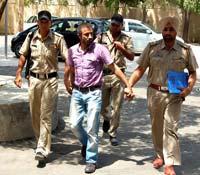Kandola gang active in Canada

One of Punjab’s top drug barons, with links to Canada, is cooling his heels in an Indian jail as cops try to unravel his massive international syndicate.
Indian police allege the group led by Ranjit Singh alias Raja Kandola was operating a party-drug manufacturing operation in Punjab, real estate scams and an illegal immigration operation.
Originally from Haibowal village in Nawashahr district, Raja had been staying in Kandola village near Adampur in Jalandhar district, Punjab. Kandola then migrated to Canada, according to police in India.
So far, police have arrested 19 persons of his gang including his wife Rajwant Kaur, their son Belly Singh, whom police acted as couriers.
Police said they started tracking Kandola after Punjab Police busted a drug manufacturing unit in Jalandhar and seized about 50 kg of ephedrine and methametaphine last June. The two substances are mixed to produce ICE — a party drug that's popular among youth. However, the kingpin of the drug cartel, Kandola, managed to escape.
On August 11, Kandola was arrested from Dwarka Link Road in Punjab.
"During interrogation, Kandola revealed that he had lived abroad for a couple of years. On returning to India in 2002, he met Kulwinder Singh Maan, a passport agent from Punjab, and got involved with a trafficking racket. The same year, he was arrested in Zimbabwe for transporting 15 illegal immigrants to the country. In jail, he came in contact with a Serbian national, Johan Milan. Milan expressed his interest in drug trafficking in India and the duo started business," said DCP (special cell) Sanjeev Yadav.
After being released, Kandola returned to India in 2004, but he was again arrested three years later. Lodged in Tihar Jail, he came in contact with Sukhjinder who was undergoing a jail term in a robbery case. Kandola was freed in 2007 and he floated a real estate business in Delhi and Punjab. In 2011, Kandola again got in touch with Sukhjinder. In February 2012, Milan contacted Kandola with a proposal to manufacture ICE in India. He came to India and stayed at Kandola' house in Punjab. They set up an ICE manufacturing unit at Jalandhar.
Yadav said the Kandola gang was active in Canada, New Zealand and several other countries.
Indian media reported that Kandola was getting help from certain police officials, whom he had been entertaining lavishly “in every possible manner at his sprawling and luxurious farm house near Samrala, Punjab”.
Kandola managed a drug empire worth crores of rupees and operated out of Punjab. He had set up a drug manufacturing unit near Samrala on an 8-acre plot with a farmhouse having luxuries on a par with a five-star hotel there. He reportedly also had set up a manufacturing facility in Gurgaon also.
Information gathered by the police from his aides, who were arrested a few months ago, revealed that Kandola had a well-knit network of people for producing the drug supply across international borders.
He had been using top models and good-looking young women fluent in English as couriers to send and receive drug-consignments, one paper said.
Several Kandolas’ have been linked to drug cases in the Greater Vancouver area but it could not be confirmed by Press Time if they were connected to the operations of Raja Kandola.
Among them are Baljinder Singh Kandola, a former Canadian border guard who has been convicted for his part in a conspiracy that saw him wave vehicles through the border that were importing cocaine and guns into Canada from Washington state.
Earlier, drug dealer Robbie Kandola was sprayed with bullets by killers waiting for him as he got out of a cab in front of his Coal Harbour apartment in Vancouver.
The Royal Canadian Mounted Police in an analytical report say drug seizures originating in India have increased dramatically becoming the number one source/transit country to Canada.
Various methods are used to import heroin into Canada such as postal and courier modes, air transport as well as by land via commercial or traffic vehicles. Particularly in the case of air passengers, an array of concealment methods are utilized to smuggle heroin that range from individuals swallowing the drug to modified suitcases, picture frames, rolling pins, statues and even hiding the heroin in a baby’s diaper bag.
India has also emerged as a source country for ketamine and other party drugs smuggled into Canada.
The RCMP report also identified Indo-Canadian criminal groups as high-level transporters of synthetic drugs and precursor chemicals from Canada to the U.S.
With an annual turnover of around US$500 billion dollars, drug trafficking is the third largest business in the world, next only to petroleum and arms trade.
Narcotics agencies say India, wedged between two major drug-producing regions, the Golden Triangle and the Golden Crescent, is a major transit point for drug smuggling to the West where returns are lucrative.
Leave a comment









